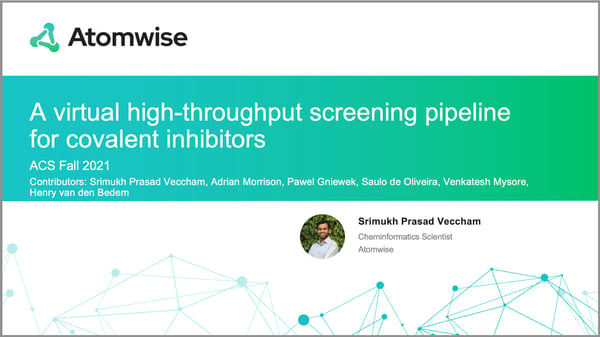A Virtual High-throughput Screening Pipeline for Covalent Inhibitors
At the American Chemical Society Fall 2021 National Meeting & Expo, Atomwise members were selected to present their research and work. Learn what our Atoms have been working on below and visit Atomwise at ACS Fall 2021 National Meeting for other presentation sessions.
 Srimukh Prasad, PhD
Srimukh Prasad, PhD
Atomwise
Atomwise Co-Authors: Adrian F. Morrison, Pawel Gniewek, Saulo de Oliveira, Venkatesh Mysore, Henry van den Bedem
Title: A Virtual High-throughput Screening Pipeline for Covalent Inhibitors
Division: Computers in Chemistry
View Presentation
Abstract
Covalent inhibitors can provide opportunities to modulate protein function with greater potency, selectivity, and duration than their non-covalent counterparts, but they are often shunned in drug discovery campaigns due to concerns surrounding off-target toxicity. The approval of multiple covalent drugs by the FDA in the last decade has prompted a resurgence of interest in this class of compounds. However, introducing covalent compounds in structure-based, deep-learning virtual high-throughput screening (vHTS) pipelines for ultra-large libraries with billions of compounds leads to new challenges. For example, the model needs to automatically detect chemical groups on the target protein and compound that can react covalently and generate correct docking poses. As the properties of decoy compounds need to closely match those of actives and as negative data for this problem is scarce, data-augmentation for this problem becomes extra challenging. Here, we address these challenges and present a structure-based, deep learning vHTS pipeline for covalent compounds. We use RDKit to detect covalent warheads based on a precompiled list of SMARTS patterns and identify electrophilic residues on the protein target near the binding site. We developed a constrained docking algorithm in CUina, Atomwise’s GPU-based implementation of the Autodock Vina, to mimic the covalent compound-protein bond. The quality of the generated poses is comparable to the state-of-the-art covalent docking protocols when compared to their corresponding crystal structures. We used these new annotations and poses to train and validate a deep learning-based vHTS model to identify covalent inhibitors. We explored multiple decoy generation strategies and assessed the effect of covalent compounds in training on the models’ performance on non-covalent vHTS tasks. Our results demonstrate that non-covalent pipelines can be successfully extended to screen covalent inhibitors in an ultra high-throughput setting.
Join our team
Our team is comprised of over 80 PhD scientists who contribute to a high-performance academic-like culture that fosters robust scientific and technical excellence. We strongly believe that data wins over opinions, and aim for as little dogma as possible in our decision making. Learn more about our team and opportunities at Atomwise.
Related Posts
Subscribe
Stay up to date on new blog posts.
Atomwise needs the contact information you provide to send you updates. You may unsubscribe from these communications at any time. For information please review our Privacy Policy.

